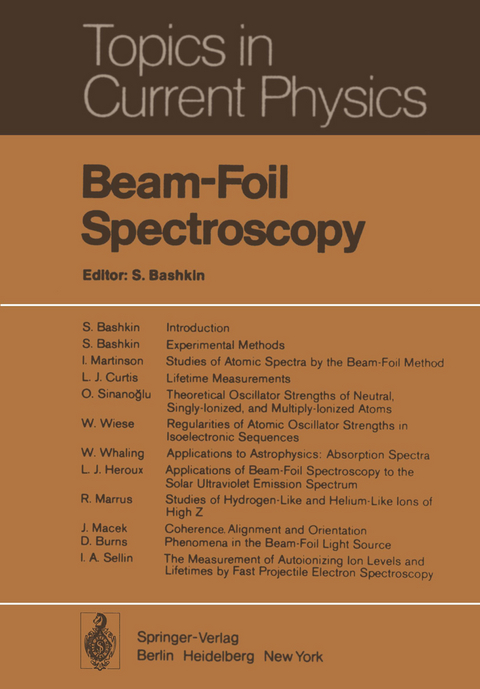
Beam-Foil Spectroscopy
Springer Berlin (Verlag)
978-3-642-81054-1 (ISBN)
Stanley Bashkin Beam-foil spectroscopy has enjoyed a rapid growth since the publication of KAY's first experiment [I.1J and my own first formal discussion of the possibilities inherent in a foil-excited particle beam [1.2J. In addition to fulfilling a number of the impor tant promises, the beam-foil source has been found to hold substantial surprises, the unearthing of which has contributed to our knowledge of basic atomic physics. Since the early days, major extensions have been made in the range of wavelength and par ticle energies which have been used, but only the bare beginnings have been made in exploiting the potential of the beam-foil source. Since there are many people who would like to turn their accelerator facilities to beam-foil problems or apply their theoretical techniques to calculations which bear on the beam-foil field, it seemed appropriate to assemble a discussion of the present status of beam-foil spectroscopy. The present volume attempts to summarize what has been learned and outlines a number of studies which remain to be made.
1. Experimental Methods.- 1.1 Accelerators.- 1.2 Ion Sources.- 1.3 Beam Requirements and Limitations.- 1.4 Mass Analyzers.- 1.5 Target Chambers.- 1.6 Targets.- 1.7 Analytical Devices.- 1.8 Detectors.- 1.9 Detection Geometry and Line Width.- 1.10 Beam Monitors.- 1.11 External Fields.- 1.12 Concluding Remarks.- References.- 2. Studies of Atomic Spectra by the Beam-Foil Method.- 2.1 Experimental Methods.- 2.2 Results of Spectral Studies.- References.- 3. Lifetime Measurements.- 3.1 Lifetime Studies as a Basic Area of Atomic Physics.- 3.2 Definitions of Basic Quantities.- 3.3 Measurement of Beam-Foil-Excited Decay Curves.- 3.4 Time Dependence of the Measured Decay Curves.- 3.5 Mean-Life Extraction by Exponential Fits to Individual Decay Curves.- 3.6 Mean-Life Extraction by Joint Analysis of Cascade-Related Decay Curves.- 3.7 Cascade-Free Methods.- 3.8 Concluding Remarks.- References.- 4. Theoretical Oscillator Strengths of Neutral, Singly-Ionized, and Multiply-Ionized Atoms: The Theory, Comparisons with Experiment, and Critically-Evaluated Tables with New Results.- 4.1 The Non-Closed-Shell Many-Electron Theory.- 4.2 A Spectroscopic Interpretation of the Charge Wave Function.- 4.3 NCMET Calculations,.- 4.4 States Not Lowest of Their Symmetry.- 4.5 New Oscillator Strengths for Intershell (KL ? KL'[M]) Transitions to Pre-Rydberg Levels (V ? pR).- 4.6 Further Examination of Remaining Correlation Effects on Oscillator Strengths with NCMET.- 4.7 Conclusion.- References.- 5. Regularities of Atomic Oscillator Strengths in Isoelectronic Sequences.- 5.1 Theoretical Basis.- 5.2 Discussion of Established Trends.- 5.3 Oscillator-Strength Distributions in a Spectral Series Along an Isoelectronic Sequence.- 5.4 Relativistic Effects and Corrections.- 5.5 Summary.- References.- 6.Applications to Astrophysics; Absorption Spectra. By Ward Whaling.- 6.1 Branching Ratios.- 6.2 Curve-of-Growth Analysis.- 6.3 Beam-Foil-Spectroscopy Measurements Needed for Astrophysical Applications.- References.- 7. Applications of Beam-Foil Spectroscopy to the Solar Ultraviolet Emission Spectrum.- 7.1 Ionization Balance in the Chromosphere and Corona.- 7.2 Excitation Balance in the Chromosphere and Corona.- 7.3 Line-Ratio Measurements of Electron Temperature.- 7.4 Line-Ratio Measurements of Electron Density.- 7.5 The Determination of Chromospheric-Coronal Abundances.- 7.6 Beam-Foil Measurements Needed for Diagnostic Methods.- References.- 8. Studies of Hydrogen-Like and Helium-Like Ions of High Z.- 8.1 The Lamb Shift in the One-Electron System.- 8.2 Lamb Shift in Two-Electron Systems.- 8.3 Radiative Decay of the 2S1/2 Metastable State of the One-Electron System.- 8.4 Forbidden Radiative Decay in the n=2 State of the Two-Electron System.- 8.5 Study of Doubly-Excited Configurations in the Two-Electron System.- References.- 9. Coherence, Alignment, and Orientation Phenomena in the Beam-Foil Light Source.- 9.1 General Theoretical Considerations.- 9.2 Alignment and Linear Polarization.- 9.3 Orientation and Circular Polarization.- References.- 10. The Measurement of Autoionizing Ion Levels and Lifetimes by Fast Projectile Electron Spectroscopy.- 10.1 The Fast-Projectile Electron Spectroscopy (FPES) Method.- 10.2 Examples of FPES.- 10.3 The Measurement of Auger Lifetimes by FPES.- References.- APPENDIX (Up-dated bibliography).
| Erscheint lt. Verlag | 13.12.2011 |
|---|---|
| Reihe/Serie | Topics in Current Physics |
| Co-Autor | S. Bashkin, D. Burns, L.J. Curtis, L.J. Heroux, J. Macek, R. Marrus, I. Martinson, I.A. Sellin, O. Sinanoglu, W. Whaling, W. Wiese |
| Zusatzinfo | XIII, 318 p. |
| Verlagsort | Berlin |
| Sprache | englisch |
| Maße | 170 x 244 mm |
| Gewicht | 580 g |
| Themenwelt | Naturwissenschaften ► Chemie ► Analytische Chemie |
| Naturwissenschaften ► Chemie ► Physikalische Chemie | |
| Naturwissenschaften ► Physik / Astronomie ► Allgemeines / Lexika | |
| Schlagworte | Strahl-Folien-Spektroskopie |
| ISBN-10 | 3-642-81054-3 / 3642810543 |
| ISBN-13 | 978-3-642-81054-1 / 9783642810541 |
| Zustand | Neuware |
| Haben Sie eine Frage zum Produkt? |
aus dem Bereich


